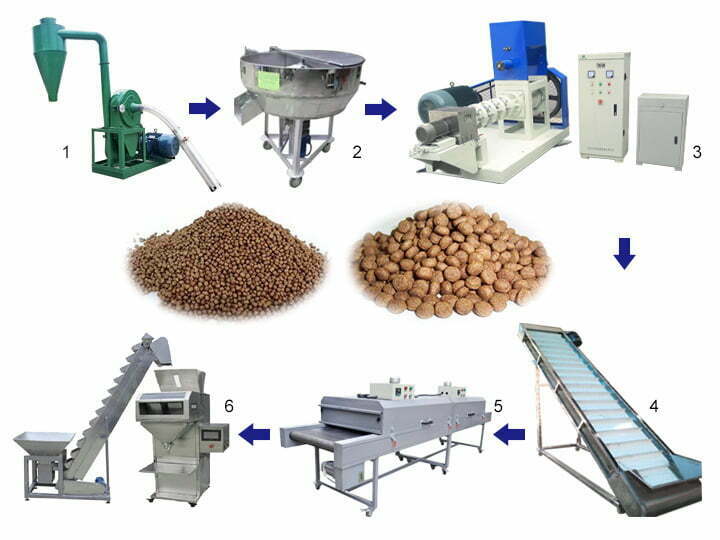फ्लोटिंग मछली का चारा गोली प्रसंस्करण लाइन मकई, सोयाबीन, गेहूं, और अन्य अनाज का कच्चा माल के रूप में उपयोग करता है ताकि चारा गोली बनाई जा सके। विभिन्न जानवरों के स्वाद के अनुसार, अलग-अलग सामग्री मिलाई जा सकती है ताकि मछली का खाना बनाया जा सके, साथ ही कुत्ते और बिल्ली का खाना भी बना सकते हैं, और अन्य पालतू जानवरों का खाना। हम अपने उत्पादन आवश्यकताओं के अनुसार विभिन्न उपज के साथ मछली का खाना गोली उत्पादन लाइनों को अनुकूलित करते हैं। इस फ्लोटिंग मछली का चारा गोली प्रसंस्करण लाइन का आउटपुट 500-600 किलोग्राम/घंटा है।
मछली पालन के लिए आवश्यक पोषक तत्व
मछली की दैनिक खपत बहुत कम होती है, और मछली का भोजन समृद्ध और व्यापक पोषक तत्वों से भरपूर होना चाहिए ताकि मछली को पर्याप्त पोषण मिल सके। इसलिए, मछली के भोजन के कणों का अनुपात विविध होना चाहिए। मछली का भोजन प्रोटीन, प्रोटीन मछली के ऊतक और अंगों का एक महत्वपूर्ण पोषक तत्व है। मछली के प्रोटीन का अपर्याप्त सेवन धीमे विकास और रोग प्रतिरोधक क्षमता में कमी ला सकता है। वसा और विटामिन मछली की प्रतिरक्षा को बढ़ाते हैं। इसके अलावा, इसमें खनिज तत्व भी उचित मात्रा में होने चाहिए।
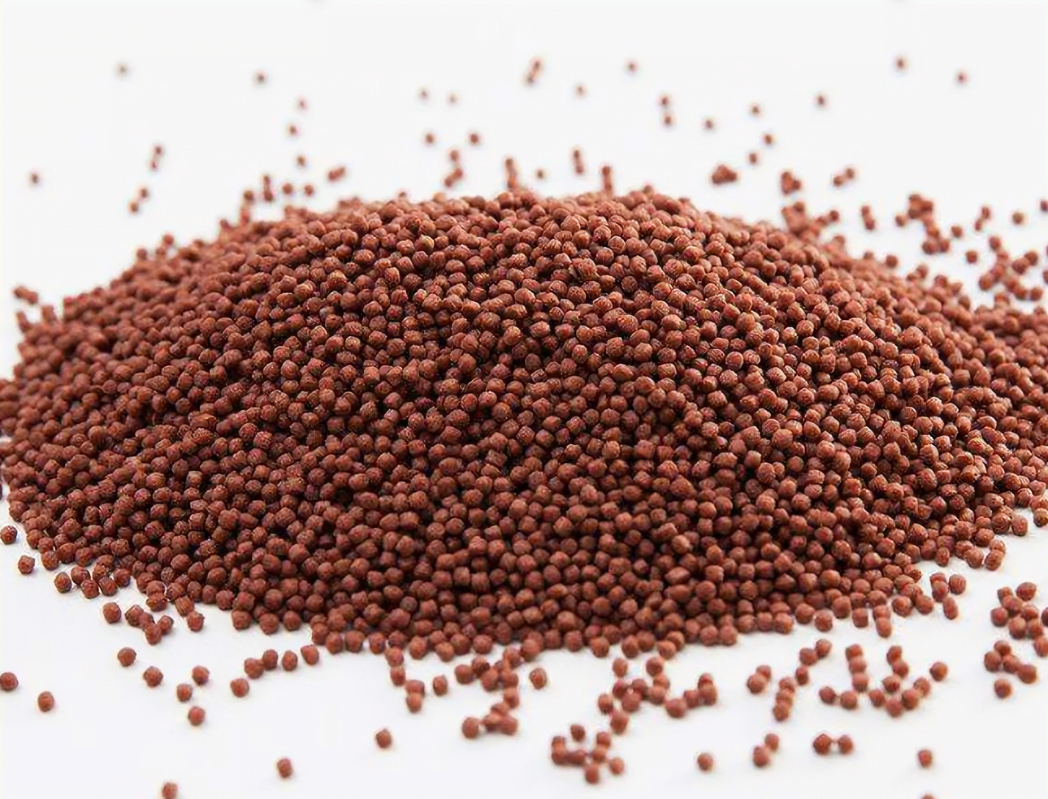
मछली के गोली के कच्चे माल में पाए जाने वाले पोषक तत्व
1। गेहूं का भूसा: फाइबर से भरपूर है और कई मछली रोगों को रोकता है।
2। मकई: प्रोटीन, कार्बोहाइड्रेट, वसा, विटामिन A और E शामिल हैं।
3। कपास के बीज: लगभग 54% प्रोटीन होता है। यह मछली का भोजन पूरक बनाने के लिए अच्छा कच्चा माल है।
4। मछली का भोजन: मछली आसानी से पच जाती है। मछली का भोजन लगभग 55-60% प्रोटीन होता है।
5। हड्डी का भोजन: मछली की हड्डियों को बनाने के लिए आवश्यक।
6। अवशेष: यह कैटफ़िश के लिए आदर्श फीड है। इसमें 52% प्रोटीन होता है।
फ्लोटिंग मछली का चारा गोली प्रसंस्करण का कच्चा माल क्रशर
कच्चे माल को क्रश करना मछली का भोजन बनाने की पहली प्रक्रिया है। कच्चे माल के lumps को पीसकर, मछली का भोजन अधिक पचने योग्य और अवशोषित करने योग्य बनता है।
| मॉडल | मोटर | क्षमता |
| 350 | 7.5kw | 500-600kg/घंटा |
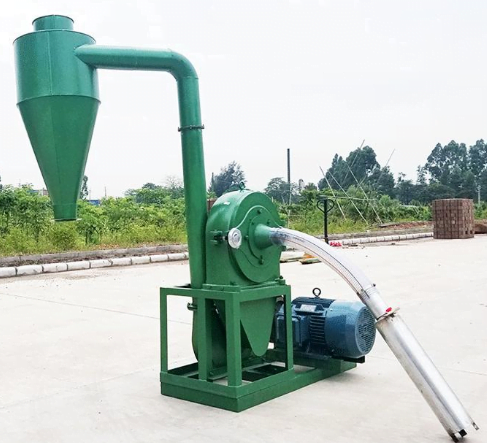
क्रशर मशीन
फ्लोटिंग मछली का चारा गोली प्रसंस्करण का मिश्रण
कच्चे माल को क्रश करने के बाद, उन्हें अनुपात में मिलाना और विभिन्न कच्चे माल में मिलाना आवश्यक है ताकि मछली का भोजन का उत्पादन किया जा सके। मिलाने और हिलाने से प्रत्येक मछली के भोजन में मौजूद पोषक तत्व समान हो जाते हैं। मछली के भोजन में सबसे कम मात्रा में जोड़ा जा सकता है। यह अधिक समान मिश्रण में सहायक है।
मॉडल | मोटर | क्षमता |
| SL-350 | 4KW | 300kg/घंटा |
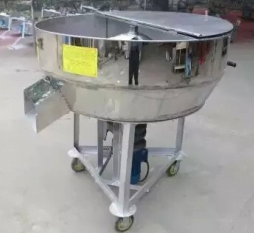
फ्लोटिंग मछली का चारा गोली प्रसंस्करण मशीन
पिछले कच्चे माल की तैयारी के बाद, अगला कदम मछली का भोजन का एक्सट्रूज़न है। मशीन के प्रसंस्करण के बाद, मछली के भोजन की गोली में मौजूद पानी अपेक्षाकृत कम हो जाएगा, जिससे बाद की सुखाने की प्रक्रिया लागत बचाने और कम समय में पूरी हो सके। मछली का भोजन गोली बनाने वाली मशीन विभिन्न आकार की मछली के अनुसार मछली का भोजन बना सकती है, सामान्यतः 1.2 मिमी से 12 मिमी के बीच। विभिन्न आकार बनाने के लिए, आपको केवल गोली मशीन के मोल्ड का आकार बदलना होगा। यह अन्य पालतू जानवरों के लिए भी भोजन बना सकती है, जैसे बिल्ली और कुत्ते का भोजन।
| मॉडल | मोटर | क्षमता | आकार | गोली |
| SL-90 | 30KW 1.5KW | 500-600KG/घंटा | 1.8*2.6*1.15m | 1.2-12mm |

कन्वेयर
ड्रायर से जोड़ने के लिए उपयोग किया जाता है, निरंतर फीडिंग की जा सकती है, जिससे मानव शक्ति की बचत होती है।
मॉडल | मोटर | आकार |
| SL-100 | 1.5KW | 3*0.6*1m |
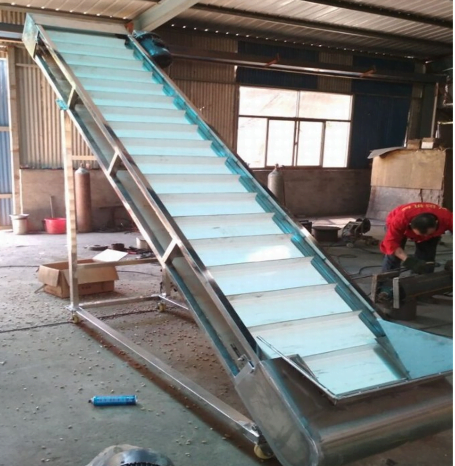
जाल बेल्ट ड्रायर
मशीन बेल्ट ड्रायर निरंतर मछली का भोजन सुखाने में सक्षम है, जिससे कम श्रम और उच्च स्वचालन की आवश्यकता होती है। सूखे हुए मछली का भोजन न केवल शेल्फ लाइफ बढ़ाने में मदद करता है, बल्कि अधिक कुरकुरा भी होता है।
| मॉडल | मोटर | क्षमता | आकार |
| SL-100 | 7.5kw | 500-600kg/घंटा | 4m*0.6*1m |

मछली का भोजन रोलर मसाले मशीन
सूखने के बाद, मछली का भोजन सीधे मसाले मशीन में डालकर मसाले डाल सकते हैं। मसाले का उद्देश्य मछली के भोजन को अधिक स्वादिष्ट और आकर्षक बनाना है। इसे उगाए गए मछली के प्रकार के अनुसार मसालेदार किया जा सकता है।
| मॉडल | वोल्टेज | स्थापित क्षमता | पावर खपत | आउटपुट | आकार |
| SL-200 | 380V | 4.6KW | 3KW | 500-600kg/घंटा | 5.5*0.75*1.95m |
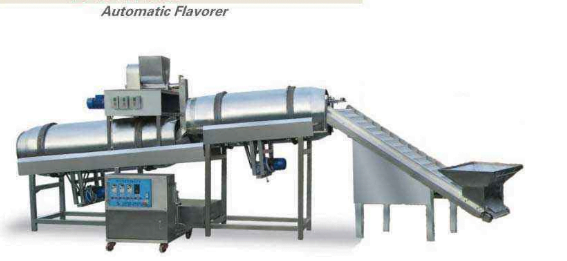
फ्लोटिंग मछली का चारा गोली प्रसंस्करण का पैकेज
उत्पादन के बाद, मछली का चारा पैक किया जा सकता है, और कसे हुए पैकेजिंग पृष्ठ से मछली के भोजन की शेल्फ लाइफ को बेहतर बनाने में मदद मिलती है।
| मॉडल | मोटर | क्षमता |
| LFS-1500 | (दो)0.75-0.75 | 300-500 बैग/घंटा |
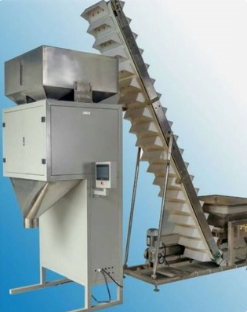
फ्लोटिंग मछली का चारा गोली प्रसंस्करण का लाभ
1। मछली का चारा गोली लोकप्रिय फीड हैं जो आधुनिक वाणिज्यिक मछली पालन के लिए आवश्यक संतुलित पोषण प्रदान करते हैं और मछली खेतों के पर्यावरण में सुधार करते हैं। बाजार में फीड गोली की उच्च कीमत के कारण, कई किसान अपने आप फीड एक्सट्रूडर खरीदते हैं ताकि गोली उत्पादन कर सकें और लागत कम कर सकें।
2। भंडारण: ठंडी और सूखी जगह में ढककर रखें, जिससे दो से तीन महीने तक संग्रहित किया जा सकता है।
3। स्वच्छता: विस्तार प्रक्रिया अधिकांश बैक्टीरिया को समाप्त कर सकती है। कम नमी (लगभग 10%) बैक्टीरिया के विकास को रोक सकती है।
4। पोषण: जानवर या वनस्पति प्रोटीन, मछली का तेल या अन्य वसा, मल्टीविटामिन, और विशिष्ट मछली की आवश्यक खनिजों को जोड़ा जा सकता है। यह पोषक तत्वों से भरपूर है और मछली के स्वास्थ्य में प्रभावी रूप से सुधार कर सकता है।
5। पर्यावरण प्रभाव: उपयुक्त आकार और घनत्व के गोली फीड का उपयोग करने से हानि दर कम हो सकती है और फीड अवशेषों से होने वाले पर्यावरण प्रदूषण को काफी हद तक कम किया जा सकता है।
6। विभिन्न आकार और घनत्व के गोली फीड बनाए जा सकते हैं ताकि विभिन्न विकास चरणों और विभिन्न शेलफिश जानवरों की आवश्यकताओं को पूरा किया जा सके। उपयुक्त आकार और घनत्व के गोली फीड का उपयोग करके, फीड अवशेषों से होने वाली हानि दर और पर्यावरण प्रदूषण को काफी हद तक कम किया जा सकता है।

